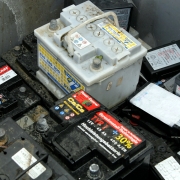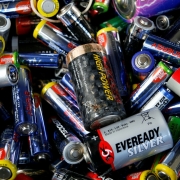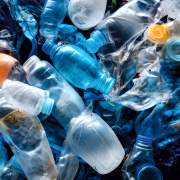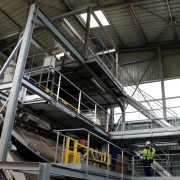Lead Recycling: Substantial Investment Is Needed
Lead has one of the highest recycling rates in the world and is also the most recycled of commonly used metals. According to the International Lead Association, the recycling rate in Europe and the USA reached 99 percent. But not so in Africa, Asia and Latin America: The Blacksmith Institute ranked the unsound recycling of lead-acid in these regions as the world’s worst polluting industry in 2012. What has to be done?
On a global scale, around 85 percent of all lead is used for the manufacturing of batteries. In Africa, these batteries are used in the mobile sector, but also for power supply and solar power storage. So every year 1.23 million tons of used lead-acid batteries and 800,000 tons of lead are waiting here for recycling, according to a study published by the Lead Recycling Africa Project. As the paper describes, in a first step a large number of small workshops buy used batteries in order to replace the sulfuric acid and to recondition or repair the object by exchanging damaged electrodes. Further on, local scrap dealers will sell the batteries to traders. As these buyers demand dry products, the scrap dealers often pour the acid – in combination with dissolved and dispersed lead – away or even out into the environment.
85 percent could potentially be recycled
In most small or industrial secondary lead smelters the lead-acid batteries cases are manually cracked and the scrap stored. During the process of informal recycling, acid and lead dust are leaking, and the stored scrap is afterwards exposed to rainfall and wind. Losses are suffered by heating and smelting the lead by an open fire. However, small informal lead-smelting is declining, as it can only process the elementary lead but not the lead-oxide from the battery, the Lead Recycling Africa Project gives account. Industrial secondary smelters apply furnaces fired by charcoal or oil, resulting in molten lead with some contaminants and lead-containing dust. The battery cases, mostly made out of plastic, are washed – only once in an open water bath that cannot fully remove lead-oxide contaminants – shredded and sold. As a consequence, the plastics for later use are cross-contaminated. The final lead bars leaving the industrial smelters do not meet the standardized level of purity and end usually in European or Asian lead refineries.
According to the International Lead Association, it is estimated that worldwide at least 85 percent of lead consumed could potentially be recycled. “However, in practice, the amount that is recovered is lower.” UNEP (UN Environment) and International Resource Panel acknowledge that lead together with ruthenium and niobium is the only metal with a recycled content higher than 50 percent. Its end-of-life recycling rate ranges from 52 to 95 percent – on condition of easily recoverable applications, large amounts and high present value.
Tremendous losses
But the life-cycle of lead is characterized by tremendous losses. In 2011, Perry Gottesfeld und Christopher R. Cherry investigated life cycle loss rates of solar photovoltaic energy systems from mining, battery production, and recycling. They estimated the loss of 33 percent in China and 22 percent in India and figured worldwide losses to the environment adding up to 2.4 million tons or one-third of the global lead production. So they underlined that “investments in environmental controls in lead smelting, battery manufacturing, and recycling industries along with improvements in battery take-back policies should complement deployment of solar PV systems to mitigate negative impacts of lead pollution”. Furthermore, they pleaded for simultaneous investment in environmental controls and product stewardship that could at best reduce losses by 47 percent in China and 44 percent in India.
Beijing researchers Jing Liang and Jian-su Mao published a paper in 2014 showing that for every kilogram of lead consumed 0.48 kg lead is lost into the environment. The emissions in 2010 were estimated to be “mainly from use (39.20 percent) and waste management and recycling (33.13 percent)”. And a recently published, comprehensive study on “soil contamination from lead battery manufacturing and recycling” comes to the conclusion, that “many lead battery recycling plants around the world have been recognized as sources of airborne lead emissions that have resulted in lead contamination of soil and dust” – not to mention their impact on surface and groundwater sources. Especially in Africa, the sampling of 118 recycling facilities detected arithmetic mean lead concentrations of 2,600 milligram/kilogram on the outside of plants and 57,700 milligram/kilogram on the inside of plants. All samples taken outside exceeded the residential soil hazard levels determined by the U.S. Environmental Protection Agency, 42 percent of the samples taken inside exceeded the specified values, and nearly all of the samples collected inside (93 percent) transcended the Agency’s criteria for industrial sites.
Measures against airborne lead level
Admittedly, this study regards mostly to very small lead (although licensed) battery recycling facilities in Cameroon, Ghana, Kenya, Mozambique, Nigeria, Tanzania, and Tunisia. Their annual processing capacity has merely a fraction of regulated plants in China and range below the capacities needed to run an economically feasible plant. But even in these facilities, little modifications are possible, Dr. Faridah Hussein Were, a University of Nairobi lecturer, reported 2015 by the example of a large-scale battery recycling plant in Kenya the conditions before and results after his research. The huge open-air stockpile of end-of-life batteries had significantly been reduced and taken to a bunker. The closing of the rotary furnace after charging reduced the airborne lead level from 195 μg/m3 to 105 μg/m3. The upgrading of the open vessel containing lead fumes diminished it from 176 μg/m3 to 98 μg/m3. And by alloying of lead into billions, the partially closing lessened the emission from 168 μg/m3 to a level of 123 μg/m3. If no measures are taken, the lack of furnace emission controls in a small scale plant can result in fumes during the lead reduction, while dismantling, reconditioning and dismantling residues will increase the airborne lead level and pollute the composite soil.
Lack of adequate infrastructure
Consequently, Dr. Faridah Hussein Were recommended a “comprehensive regulatory framework for lead-acid battery recycling operations”. At that time, the NGO Occupational Knowledge International couldn’t inspire great hope that this would happen locally or even worldwide. According to the organization, “China, India and some other countries already have general laws requiring lead battery manufacturers to take back used batteries for recycling. However, these are largely ineffective because they do not provide financial incentives and do not impose penalties for noncompliance.” With the exception of the United States, where lead battery recycling facilities got subjects to the strictest national emission standards of any country. But in 2014, the United States Environment Protection Agency still stated: “Metals industrial processing is one of the largest sources of lead emissions.”
Meanwhile, things might have changed. The Status Report on Recycling Rates of Metals, released by UNEP and the International Resource Panel in 2011, was able to declare: “Most of the nonferrous metals are widely enough used and often sufficiently valuable, that their recycling and reuse is reasonably high. This is especially true for lead, which is mostly used in large vehicles, and industrial batteries that are returned and subsequently recycled in commercially and industrially linked recycling.” That may be correct for several developed countries but does not apply to all facilities worldwide. Not without reason the United Nations Environment Assembly (UNEA) 2016 adopted a resolution noting “the lack of adequate infrastructure needed to recycle the rapidly growing number of waste lead-acid batteries” and “the need to further reduce releases, emissions and exposures”. And in December 2017, UNEP additionally decided to call for accelerated action and strengthened partnerships in “eliminating exposure to lead paint and promoting environmentally sound management of used lead-acid batteries”.
Investment to make improvement
The Lead Recycling Africa Project gets more precise in formulating effective measures against unsound lead-acid battery recycling in Central Africa and beyond. The list of request demands – amongst others – the development of collection and take-back schemes based on the principle of extended producer responsibility, stringent standards and requirements implemented by governments as well as by regulatory bodies, assurances of the lead-consuming industries to source from facilities and supply chains with best available recycling and processing technologies, not to forget a transfer of know-how and technologies to developing countries and emerging economies. The “Soil Contamination”-Study postulates: “Few countries in Africa have industry-specific regulations governing the operations and emissions from lead battery recycling. There is an immediate need to establish such regulation to prevent ongoing emissions and the resulting soil contamination.” And Dr. Faridah Hussein Were reduces the necessities to the brief denominator: “Substantial investment is needed to make improvement in the (recycling) industry.”
Photo: wikimedia
GR 3/2018








